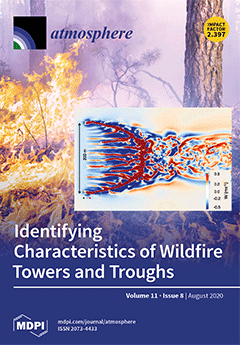This study presents the spectral monthly and seasonal variation of aerosol optical depth (τ
AOD), single scattering albedo (SSA), and aerosol absorption optical depth (AAOD) between 2010 and 2018 obtained from the Aerosol Robotic Network (AERONET) over Pokhara, Nepal. The analysis of
[...] Read more.
This study presents the spectral monthly and seasonal variation of aerosol optical depth (τ
AOD), single scattering albedo (SSA), and aerosol absorption optical depth (AAOD) between 2010 and 2018 obtained from the Aerosol Robotic Network (AERONET) over Pokhara, Nepal. The analysis of these column-integrated aerosol optical data suggests significant monthly and seasonal variability of aerosol physical and optical properties. The pre-monsoon season (March to May) has the highest observed τ
AOD(0.75 ± 0.15), followed by winter (December to February, 0.47 ± 0.12), post-monsoon (October and November, 0.39 ± 0.08), and monsoon seasons (June to September, 0.27 ± 0.13), indicating seasonal aerosol loading over Pokhara. The variability of Ångström parameters, α, and β, were computed from the linear fit line in the logarithmic scale of spectral τ
AOD, and used to analyze the aerosol physical characteristics such as particle size and aerosol loading. The curvature of spectral τ
AOD, α’, computed from the second-order polynomial fit, reveals the domination by fine mode aerosol particles in the post-monsoon and winter seasons, with coarse mode dominating in monsoon, and both modes contributing in the pre-monsoon. Analysis of air mass back trajectories and observation of fire spots along with aerosol optical data and aerosol size spectra suggest the presence of mixed types of transboundary aerosols, such as biomass, urban-industrial, and dust aerosols in the atmospheric column over Pokhara.
Full article





